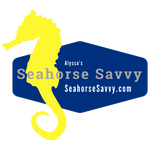Basic Care Information
Aquarium
A 30 gallon aquarium is the minimum recommended aquarium size for a pair of our captive bred seahorses. An additional 15 gallons is recommended for every additional pair of seahorses. A larger aquarium is even better. Minimum aquarium height is 18 inches.
Make sure your aquarium has plenty of “hitching-posts” for your seahorses to hold onto. Artificial branching coral or live Gorgonian corals are great hitching posts.
Seahorses do best in a species only aquarium without stinging corals, anemones, clams or aggressive fish/invertebrates.
Temperature
Recommended temperature is 70-74F. Your heater should have a guard or be in a sump where your seahorses can not grab hold.
Feeding
Seahorses need to be fed 2-3 times daily. We use both Hikari BioPure Mysis shrimp and PE Mysis shrimp. Either or both will work for you. Spirulina enriched frozen brine shrimp can also be fed as an ocassional snack to diversify your seahorse’s deit.
Uneaten frozen food should be removed from the aquarium after 30 minutes as it will begin to spoil.
Water Parameters
|
Parameter |
recommended level |
|
specific gravity |
1.020-1.025 |
|
pH |
8.1-8.4 |
|
alkalinity |
8-12 Dkh |
|
aMMONIA (nh3) |
UNDETECTABLE |
|
NITRITE (no2) |
UNDETECTABLE |
|
nITRATE (no3) |
(IDEALLY UNDETECTABLE) <25 PPM |
|
PHOSPHATE (PO4) |
(IDEALLY UNDETECTABLE) <0.2 PPM |
|
cALCIUM |
350-450 PPM |
|
MAGNESIUM |
1250-1350 PPM |
|
TEMPERATURE |
70-74 F |
IMPORTANT: Please make sure your saltwater aquarium is fully cycled before purchasing and adding your seahorses! If you have any questions about cycling your aquarium please contact us, we are happy to help.
Equipment and Maintanance
We strongly recommend having a good quality protein skimmer on your aquarium. Weekly 10-25% water changes are recommended.
Thank you for reading. Our captive bred seahorses are hardy and a lot of fun to keep. If you have any questions about the caring for our seahorses please contact us. We want you to be a sucessful keeper and are more than happy to help.
Dwarf Seahorse Articles-Hippocampus zosterae
Dwarf Seahorses-Setting up a Proper Aquarium
https://seahorsesavvy.com/blogs/news/dwarf-seahorses-setting-up-a-proper-aquarium
Hatching Artemia (Baby Brine Shrimp) for Dwarf Seahorses and Seahorse Fry
Seahorse Articles-Larger Species (Not Dwarf Seahorses)
Tank Mates for Captive Bred Seahorses-Saltwater Fish
https://seahorsesavvy.com/blogs/news/tank-mates-for-seahorses-fish
Tank-mates for Captive Bred Seahorses-Live Corals
https://seahorsesavvy.com/blogs/news/tank-mates-for-captive-bred-seahorses
How to Sex a Seahorse
https://seahorsesavvy.com/blogs/news/how-to-sex-a-seahorses
Training Your Seahorse to Feed at a Feeding Station
https://seahorsesavvy.com/blogs/news/training-your-seahorse-to-feed-at-a-feeding-station
Acclimating Your New Seahorse to Your Aquarium
https://seahorsesavvy.com/blogs/news/acclimating-your-new-seahorse-to-your-aquarium
Seahorse Savvy-Reidi x Erectus Hybrid Seahorses
https://seahorsesavvy.com/blogs/news/seahorse-savvy-reidi-x-erectus-hybrid-seahorses
Piebald Seahorse Gallery and Info
https://seahorsesavvy.com/blogs/news/piebald-seahorse-gallery
Encouraging Brighter Seahorse Coloration
https://seahorsesavvy.com/blogs/news/promoting-brighter-seahorse-coloration
Rinsing Your Frozen Foods for Your Seahorses
https://seahorsesavvy.com/blogs/news/rinsing-your-frozen-foods-for-your-seahorses
